This post may contain affiliate links. If you click through a link and make a purchase, I may receive a commission at no additional cost to you. As an Amazon Associate, I earn from qualifying purchases. Read the full disclosure here.
Shoulder pain during exercise is a common and frustrating experience, and shoulder tendonitis is one of the most common injuries that lead to seeking physical therapy.
At first glance, you may be tempted to just “work through the pain,” but in the long run, that approach can lead to more severe problems that take longer to correct.
Injury prevention is a key piece to maintain healthy shoulders. Many cases of shoulder pain result from an overuse injury.
How do you keep your shoulders healthy? Start by reading this article!
If you’re already a pro with shoulder anatomy, use the table of contents to skip straight to the tips.
Disclaimer: This content is for educational purposes and is not medical advice. Read the full disclaimer.
Shoulder joint anatomy
To prevent shoulder pain during exercise, we need to start by understanding the shoulder itself.
Let’s take a minute to give some credit to the shoulder.
As one of the most mobile joints in the body, this freedom of movement allows us to perform every day and recreational activities. But that extra mobility comes at some cost, in this case, stability, making the shoulder more vulnerable to injury.
Though classified as a “ball and socket” joint (which sounds stable, right?), the socket piece is not much of a socket at all.

The joints of the shoulder include the glenohumeral joint (the ball and socket connecting the upper arm (humerus) to the shoulder blade (scapula).
The AC joint (acromioclavicular joint), joins the upper part of the scapula with the collar bone (clavicle). The opposite end of the clavicle joins the sternum (breast bone) at the SC (sternoclavicular) joint.
Meanwhile, the rest of the scapula (on the back) is held in position only by muscles, which is why back strength plays such a large role in the stability of the shoulder.
The labrum is made of cartilage and runs the entire rim of the “socket” attempting to deepen it to make the joint surfaces fit together seamlessly.
An assortment of ligaments and thick joint capsule tissue overlay all of these joints for added stability.
You’ll never look at Halloween skeleton the same way again.
Muscle groups of the shoulder and upper arm
The rotator cuff
Ah, the famous (or infamous) rotator cuff – depending on your experience.
Yes, cuff, like a cuff on a shirt. Not rotator cup. Friendly PSA.
The rotator cuff is a group of four different muscles; supraspinatus, infraspinatus, subscapularis, and teres minor. Together they form the innermost layer of muscular stability to the shoulder.

Supraspinatus is most frequently injured due to its location and job. When the skeleton puzzle comes together, the acromion of the scapula forms a body arch over the top of the supraspinatus muscle.
Altered movement can easily cause shoulder impingement and rotator cuff tendonitis.
Shoulder tendonitis, rotator cuff tendonitis, and shoulder impingement syndrome are frequently used interchangeably.
Supraspinatus’s main job is to assist with initial lifting into abduction to clear the top of the humerus from the arch (instead of colliding.) The other three muscles are responsible for various internal and external rotation functions of the shoulder.
Not to sound like I’m downplaying their role, but I know you don’t have all day.
The rotator cuff helps with fine-tuning the three-dimensional movements of the shoulder.
When shoulder mechanics become altered (due to posture, overuse, injury, muscle weakness), the supraspinatus tendon can become pinched between the top of the humerus and the arch of the acromion in certain positions.
Not “humerus” at all!
This impingement can lead to inflammation, tendonitis known as impingement syndrome, and eventually a rotator cuff tear if left untreated.
But impingement is just what’s happening; it doesn’t tell you how it happened.
Many different scenarios of muscle weakness, injury, flexibility restrictions, and poor posture can upset the functional balance ultimately leading to impingement and other diagnoses.
Your physical therapist will perform a full evaluation to determine the issues that need to be addressed.
I’ve included some stretching and strengthening exercises in each section to help put a face to a name.
Still, these are just some of the many options out there to illustrate. It’s also important to know that you never really just work one muscle at a time, others are assisting even if it’s on a stabilization level.
The more compound the movements get, the more muscles are worked. For example, an isolated biceps curl works the biceps, however, a row works the biceps, posterior shoulder, and upper back muscles all at the same time.
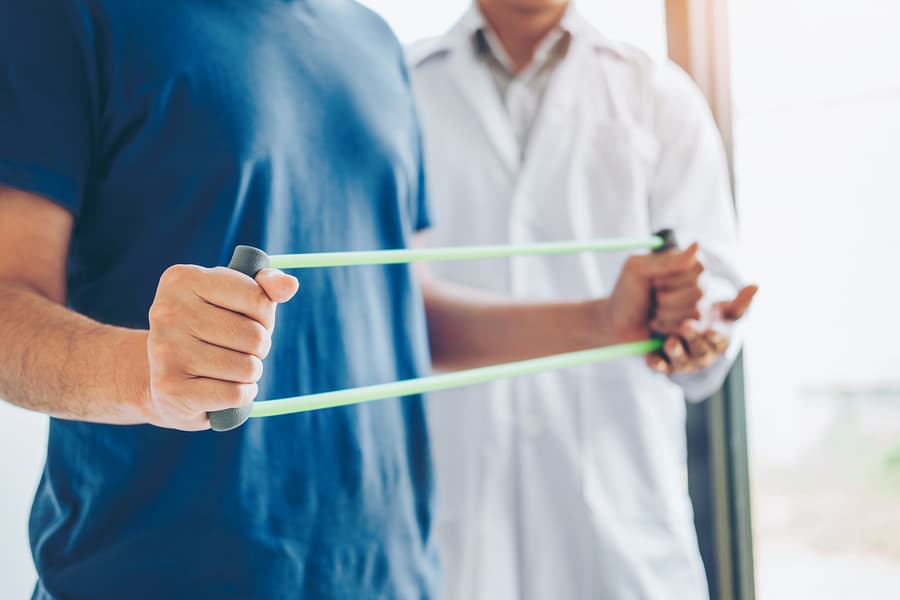
Rotator cuff strengthening exercise examples
- isolated motions with resistance bands in various planes
- stability exercises such as “wax on wax off” ball circles on a wall
- resistance band exercises in diagonal patterns
- supraspinatus: shoulder flexion in the scapular plane making a V-like motion, below the height of the shoulder.
Rotator cuff stretches
Mobility exercises using a stick – moving the arm into rotations at various angles, cross-body arm stretch, doorway stretch.
Most people’s experience with rotator cuff exercises includes standing at a doorway with their elbow at their side, performing basic internal and external rotation motions. (Boring!)
This is only one way! Remember, the shoulder is three-dimensional. Every time we move or reach, the demand on the muscles is altered somewhat.
If you do a lot of overhead reaching, yard work, heavy strengthening, or like to throw the baseball around on weekends, just doing this one way probably isn’t going to help you too much. The reason: you don’t live with your shoulder by your side 24/7.
I’m not saying this way doesn’t have a time and a place.
There are many different ways to improve the strength of the rotator cuff muscles and train your shoulder in more functional ways. See a physical therapist for some other creative ways to train this group to support your shoulder for your activities. (End soapbox rotator cuff rant.)
Deltoid
The deltoid is the outermost layer of the shoulder muscles. It has front, side, and rear (anterior, lateral, and posterior) portions. It wraps around the shoulder joint, supporting different movements in different planes of motion and helps with the overall stability of the shoulder.

The deltoid is a little more straightforward. The anterior deltoid performs shoulder flexion. The lateral deltoid performs abduction to move the arm out to the side. The posterior deltoid facilitates shoulder extension to move the arm backward.
Deltoid strengthening exercises
- front raises and overhead press (anterior deltoid)
- lateral raises (lateral deltoid)
- rows (posterior deltoid
Deltoid stretches
Stretches that target the deltoid include: Clasping hands at the lower back and puffing out the chest (anterior deltoid), pulling the arm across the body (posterior deltoid).
Due to its location, it’s tough to stretch the lateral deltoid. It has to be able to move in the opposite direction as the action it performs. In this case, the body kind of in the way. You can get a stretch by pulling the arm crossbody while lowering the elbow down toward the abdomen.
Pectoralis major/minor
Pectoralis major is the larger of the chest muscles. It covers a lot of surface area with attachments to the sternum, upper ribs, clavicle, and deep fascia of the external oblique. The opposite side of this muscle attaches to the front (anterior) side of the humerus.

When we think of pec muscles, we think of push-ups, pec deck machines, and bench press. The pec major is a push muscle but also acts to bring the arm across the body and rotate the shoulder inward.
The pec minor doesn’t get as much attention, probably because you can’t see it. It’s underneath the pec major, and it’s more of a stabilizer and a fine-tuner between the upper ribs and the scapula.
Because of our digital world, poor posture can cause the pec muscles to become tight and upset the balance of the shoulder, leading to pain.
Pec strengthening exercises
- push-ups
- chest flies
- seated chest press machine
- cable crossovers
- bench press
Pec stretching exercises
Stretches that target the pecs include doorway stretch in both a Y and goal post position, lying supine on a foam roller, and relaxing the arms out to a T and Y positions.
Biceps
The biceps primary function is bending the elbow and rotating the palm upwards (elbow flexion and forearm supination.) But it also has a small role in shoulder flexion due to where the long head attaches.
Biceps means two heads. So while we typically think of Popeye and the muscle being in the center of the upper arm, the biceps can affect the shoulder as well. The tendon of the long head fuses in with the labrum and capsule at the front of the shoulder.
Anyone that has ever suffered from biceps tendonitis will tell you this can be painful and affect shoulder ROM (range of motion).
Biceps strengthening exercises
- bicep curls
- rotating bicep curls
- compound movements such as rows and lat pulldowns
Biceps stretches
Stretches that target the biceps include shoulder and elbow extension, clasping hands behind back and extending the wrists.
Triceps
Check the pattern, triceps = three heads.
This large muscle spans the entire posterior side of the upper arm – and makes you look great in your tank tops.
The primary job of the triceps is to extend the elbow. However, the long head of the triceps does a little more work and assists with shoulder extension and adduction because of its attachment to the scapula.
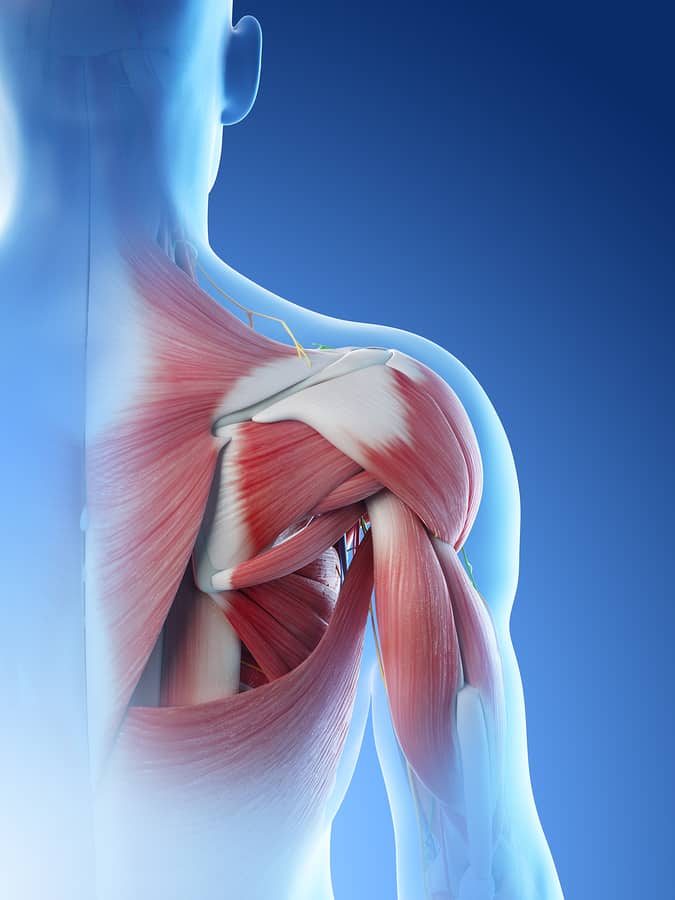
Triceps strengthening exercises
- triceps kickbacks
- overhead triceps press
- push-ups
- triceps push-up
- dips
Triceps stretch
Stretches that target the triceps: flexion of the elbow and the shoulder will target all three heads of the triceps.
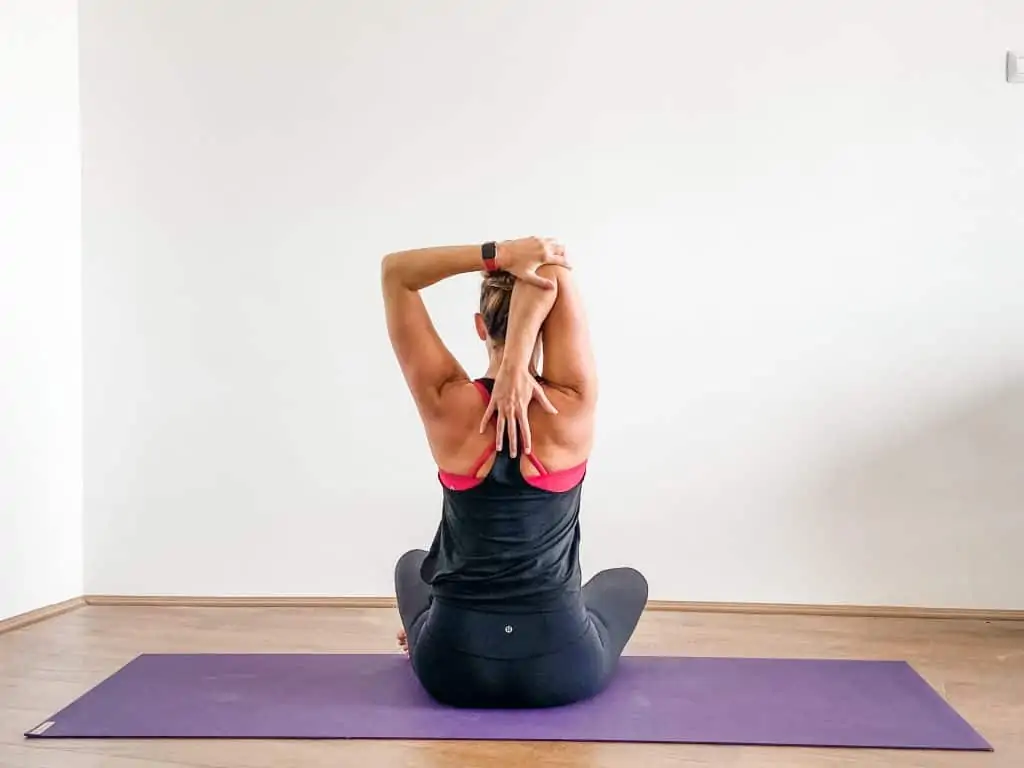
Scapular stabilizers
There are a total of 17 different muscles that have an attachment of some kind to the scapula.
Talk about being pulled in too many directions!
Like we said before, the “shoulder blade” portion of scapula is held in place by muscles, making stability a necessity for proper mechanics and pain-free shoulder ROM.
Some of the major scapular stabilizing muscles include the trapezius (upper/middle/lower), the rhomboids, serratus anterior, and levator scapulae.

Scapular strengthening exercises
- rows
- planks
- push-ups (plus*) with scapular protraction/retraction
- IYTWs in prone or over a ball
Scapular muscle stretches
- cat-cow
- eagle pose arms
- thread the needle
Body and movement awareness are essential for all exercises, but especially important when focusing on scapular stabilizers. Since you can’t see what’s going on behind you, you need to rely on other sensations and cues from your body to learn how to do it right.
For those of you thinking, “My posture is just bad, I never can tell if I’m doing this right,” Improve Your Body Awareness for Injury Prevention is a must-read!
Latissimus dorsi
Hold on. I thought the lats were a back muscle?
Yes, they are.
The lats originate in the lower back and have attachments to the pelvis, lumbar spine, and lower ribs creating that V-tapered look. They also have a small attachment on the bottom angle of the shoulder blade on their way to the humerus.
The lats have a few functions, one of the major ones being pulling up your body weight.
Having strong lats is vital to be able to do things like pull-ups or swimming. The lats are a direct connection between the core and the shoulder and tightness may make it difficult to raise your arm over your head.
Lat strengthening exercises
- lat pulldowns
- single-arm row
- pull-ups/assisted pull-ups
- bent over row
Lat stretch examples
- downward dog
- puppy pose
- standing pull away stretch
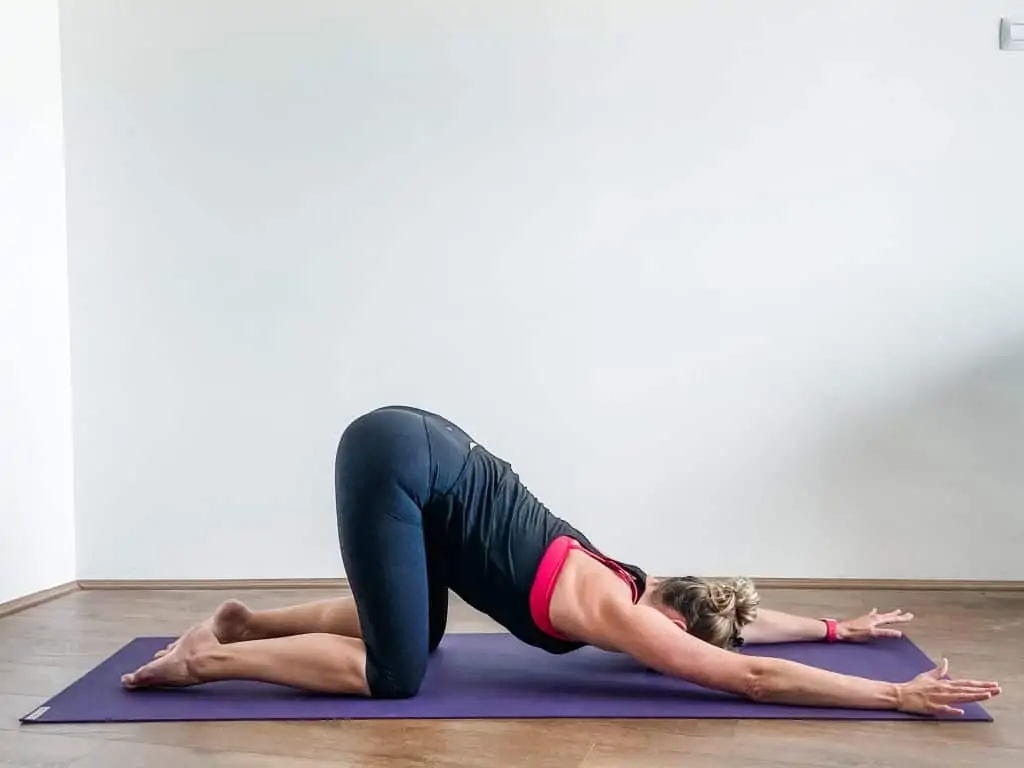
Other tissues of the shoulder
There are also small fluid-filled sacs called bursa that act to ease friction between gliding tissues. Bursa can become irritated, leading to shoulder bursitis.
Healthy shoulders starts with posture
Slump over as far as you can and then try to raise your arms over your head.
Awkward right?
Now stand up as straight as you can and try it again. Much better.
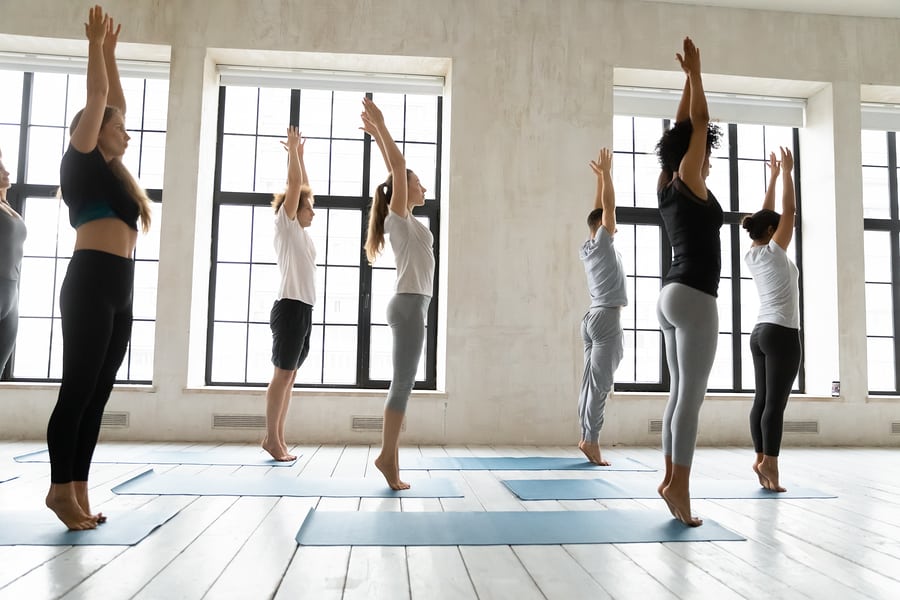
Now think of all the times that your posture has been less than optimal, and you’ve asked your shoulders to work from this awkward position.
Shoulder pain is one of the most common complaints that cause people to seek physical therapy. Self-monitoring your posture and alignment during exercise is an essential component for rehabbing and maintaining healthy shoulders.
Exercises to avoid with shoulder pain
These exercises aren’t bad, it’s just that they’re often performed incorrectly. Poor form with these exercises can cause or worsen existing shoulder pain.
Exercises such as lateral raises, overhead triceps or shoulder work, upright rows, dips, and lat pulldowns behind the head can cause or worsen shoulder pain.
Read the full article 8 Exercises To Avoid With A Rotator Cuff Injury to learn common mistakes that can cause shoulder pain.

Should I workout with shoulder pain?
That depends, let’s take a closer look.
Having shoulder pain doesn’t automatically mean you can’t exercise. It depends on the injury and what type of activities you do.
The other important piece is to avoid the downward spiral to severe pain and loss of function.
What does that look like?
I have some shoulder pain, but it’s not that bad, so I’m going to ignore it and work through it. I just overdid it. I’ll be fine in a day or two.
My shoulder is getting a little more painful, I’m not going to use it as much, and it will go away. Two Advil should help.
(Now said shoulder doesn’t go through full ROM and flexibility regularly and can become stiffer).
Weeks pass.
I’m not using my shoulder as much, but it’s bothering me more. Now I’m having trouble just reaching for basic everyday things.
My shoulder hurts all the time – I better go to the doctor. Hopefully, I can just get a prescription and have this cleared up in a day or so.
This story is all too familiar to some who have found themselves with a frustrating case of shoulder impingement or frozen shoulder (AKA adhesive capsulitis). Don’t ignore shoulder pain! Have it checked out by a physical therapist, sooner than later.
While some shoulder pain may seem “mysterious” and appears to come and go for no apparent reason, not to worry, PT’s see this all the time. It’s common when the issue is due to poor shoulder mechanics.
Everyone may not go through such an extreme pattern. If the pain is limiting you from performing everyday duties or doing the activities you enjoy, get it checked.
Depending on your diagnosis, it may be possible to continue exercising with modifications and eliminating specific movements.
*Discuss with your physical therapist for what will be right for you.*
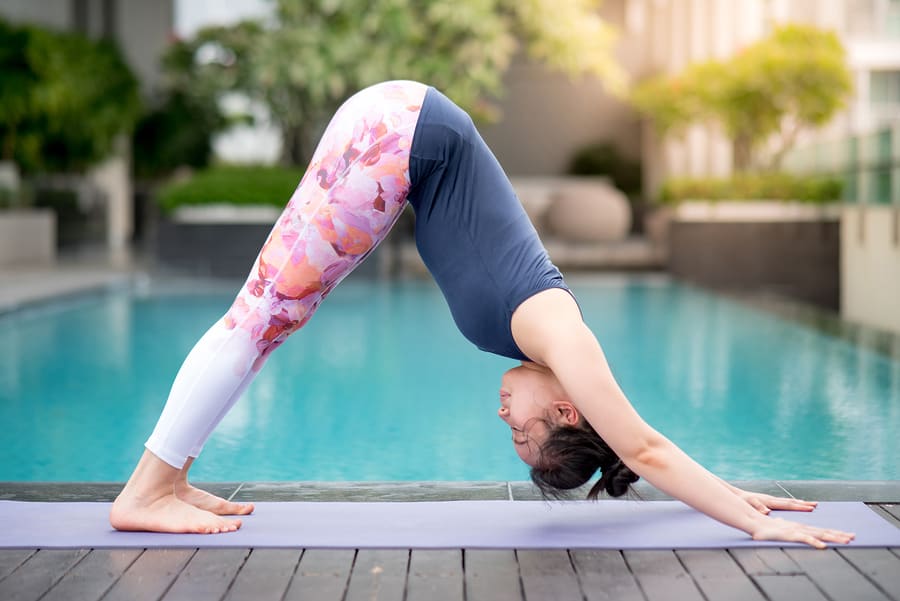
Yoga poses to avoid with shoulder pain
At the risk of sounding like a cop-out answer, anything that makes your shoulder pain worse.
Everyone’s anatomy is a little different. What bothers one person may not bother another, even if they have the same injury.
Here are some poses to avoid: poses that place full weight on the shoulder such as plank, downward dog, and side plank. Binds can put shoulders in extreme rotational ROM and can increase pain. Even raising your arms overhead like in warrior 1 can increase pain.
Basically, anything that puts weight through the shoulder, twists the joint, or places your shoulder in a ROM that causes pain for you, should be avoided. Take arm variations that work for you.
Make sure you’re taking advantage of Yoga accessories props, blocks, straps, etc., to modify poses to your level and take some stress off of your joints.
How to avoid shoulder pain while working out
Pay attention to posture and form
Always maintain good posture and form during exercise.
Never swing weights or use momentum to accomplish a movement.
If you notice you’re feeling all of the work in your neck, you need to lighten your weights and check in with your form.
Wear clothing that allows you to move through full ROM.
Work muscle groups evenly
It’s all about balance.
Neglecting any of the major muscle groups can lead to shoulder pain. Back and scapular strength are essential in maintaining healthy shoulders.
Check in with your range of motion
Discomfort and slight loss of ROM can be one of the first signs of a developing shoulder issue. It’s often subtle and ignored.
Difficulty sleeping on the affected side or difficulty with reaching behind your back are also common initial signs that shouldn’t be overlooked.
Try these tests to easily check your shoulder mobility at home.
Check-in with muscle groups such as pectorals and lats, tightness in these tissues can significantly affect shoulder ROM.
Work on thoracic spine mobility
Mobility of the thoracic spine, especially extension and rotation, contributes to healthy shoulder mobility. Remember, it’s all connected!
Related: Mobility vs. Stability vs. Flexibility – How To Unlock Healthy Movement
Modify exercises to avoid exacerbating symptoms
This includes doing your research and asking instructors for modifications, even if they’re not provided.
If you exercise at home or do workout videos, try to find programs that will offer modification options to you.
Don’t ignore your rotator cuff
Don’t forget to target the smaller stabilizing muscles. This is never as fun as the big movements for larger muscle groups, but this is the fine-tuning that helps keep everything moving smoothly. You don’t see results in the same way, but you can feel results.
Caution with weight selection for shoulder exercises
The smaller the muscle group, the lighter the weights. Weights that are too heavy for the exercise can cause you to compensate with other muscle groups and affect form.
Work with a physical therapist
Get pain checked out early!
If you have chronic shoulder issues (arthritis and other degenerative changes, etc.) work with a physical therapist.
A PT can help determine what exercises you need to maintain optimal shoulder health and function for you and how to modify exercises.
If you work with a personal trainer, make sure they understand how to modify and work around limitations.
While it is not within their professional scope to diagnose and treat injuries, they should have a basic understanding of how to modify exercises, provide substitutes, and not make your pain worse.
Related: How To Prepare for Your First Physical Therapy Appointment
Wrapping up
Shoulder pain can be exhausting and physically limiting. Only when there’s an injury, do we realize how much we rely on our shoulders daily.
Maintaining healthy shoulders is a lot easier than rehabilitating an injury. If you have shoulder pain during exercise, get it checked out sooner than later to keep your shoulders healthy and happy.
What’s next? Join the free 5-day fitness injury prevention challenge!
featured image credit: loriklaszlo / depositphotos.com
References
Chan HBY, Pua PY, How CH. Physical therapy in the management of frozen shoulder. Singapore Med J. 2017;58(12):685-689. doi:10.11622/smedj.2017107
Neumann, DA (2003). Kinesiology of the Musculoskeletal System: Foundations for Physical Rehabilitation. St. Louis, MO: Mosby.
Netter FH (2003). Atlas of Human Anatomy. Third Edition. Teterboro, NJ: Icon Learning Systems.
Terry GC, Chopp TM. Functional anatomy of the shoulder. J Athl Train. 2000;35(3):248-255.

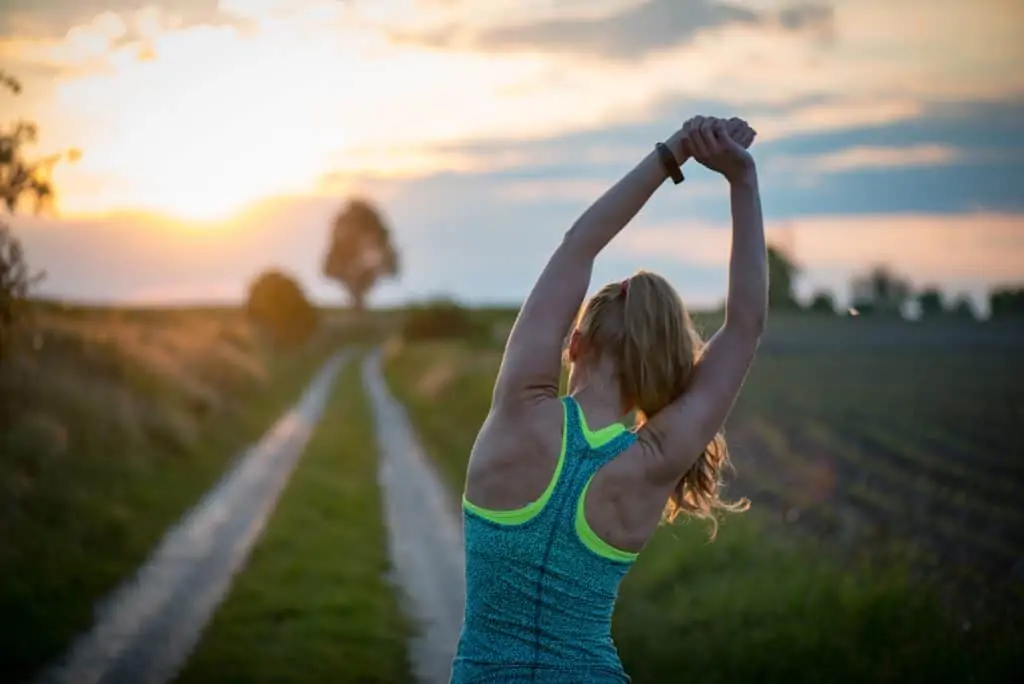
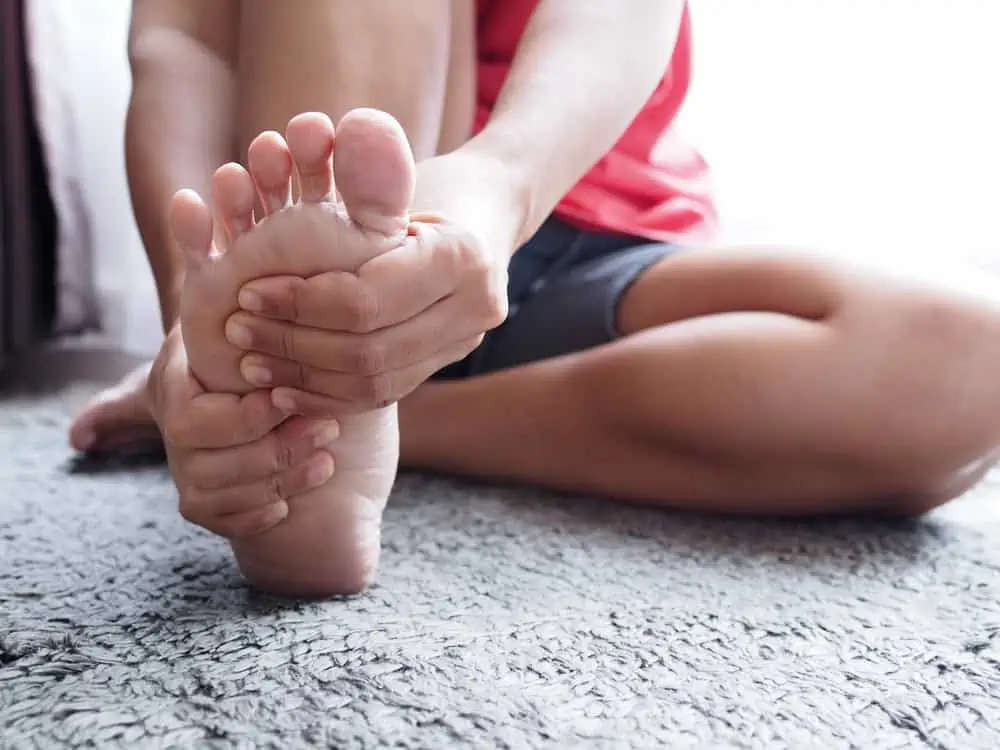
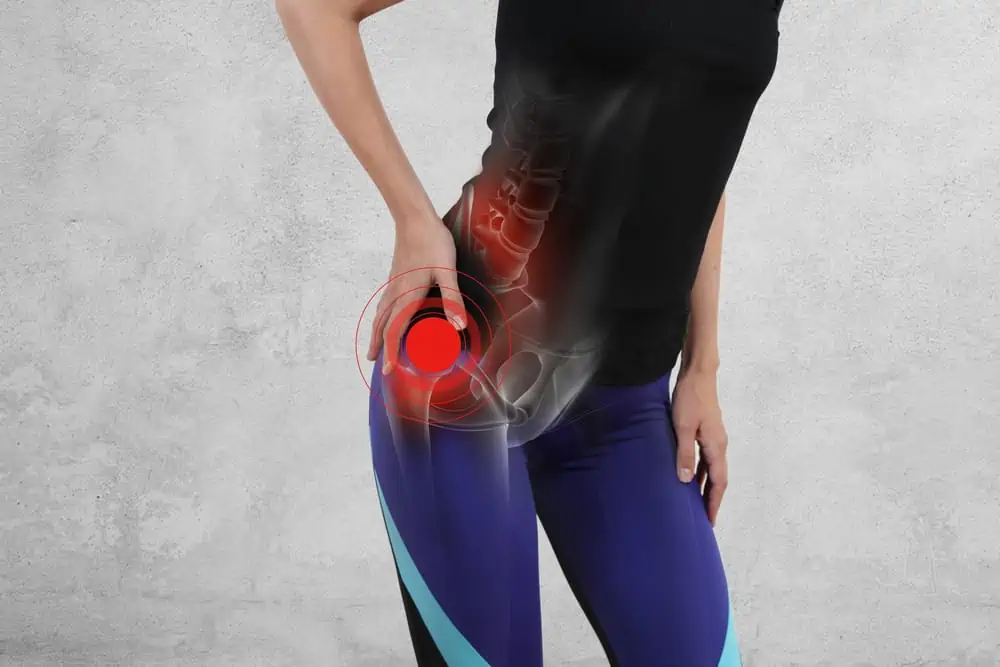
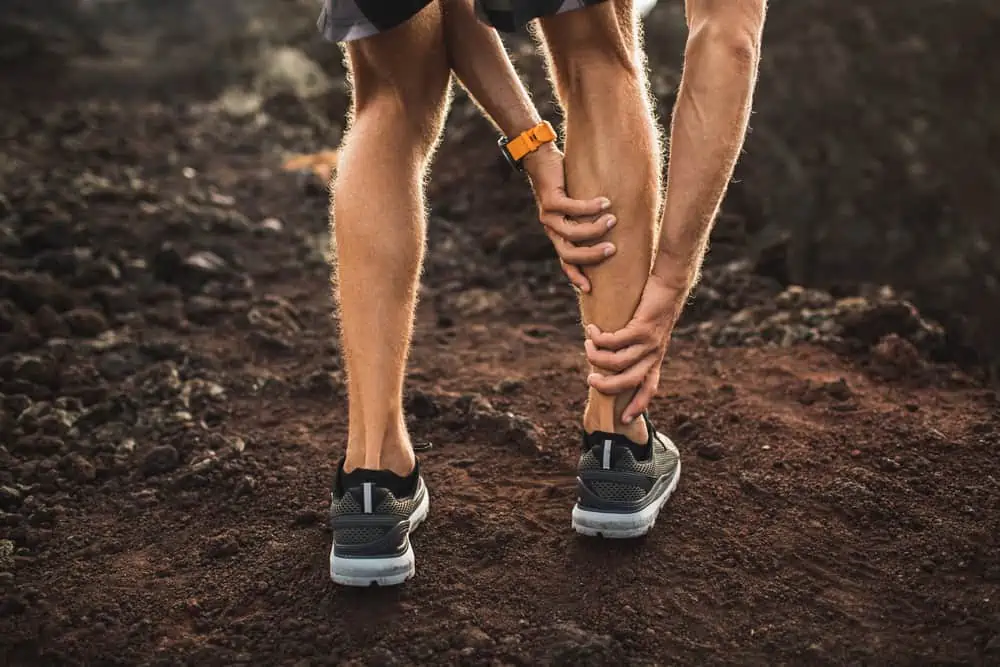
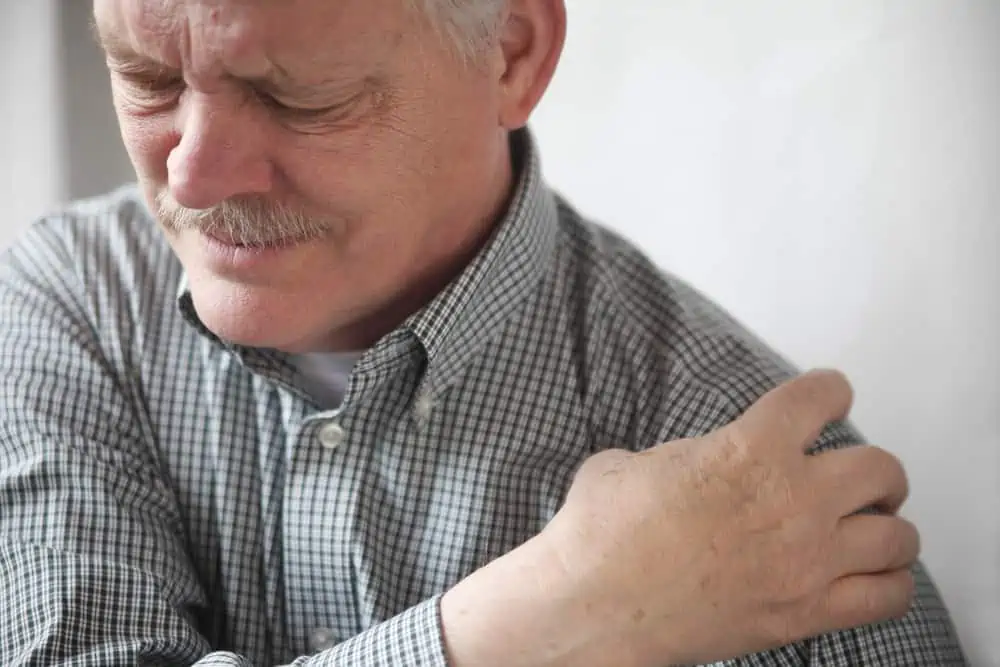

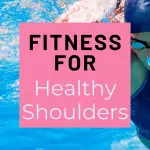
Great information! I started having trouble with my shoulders a couple of years ago. I also have a herniated disc in my lower back, could this be a contributing factor? I will definitely be coming back to reference this article. Thank for all the information!
Anything that affects your posture and overall movement can contribute, definitely get an assessment by a physical therapist. Thanks for reading!
Very detailed and helpful. I sit at a desk all day and have horrible posture. I will be using some of your tips to help myself out. Thank you!
Awesome, thank you for reading!